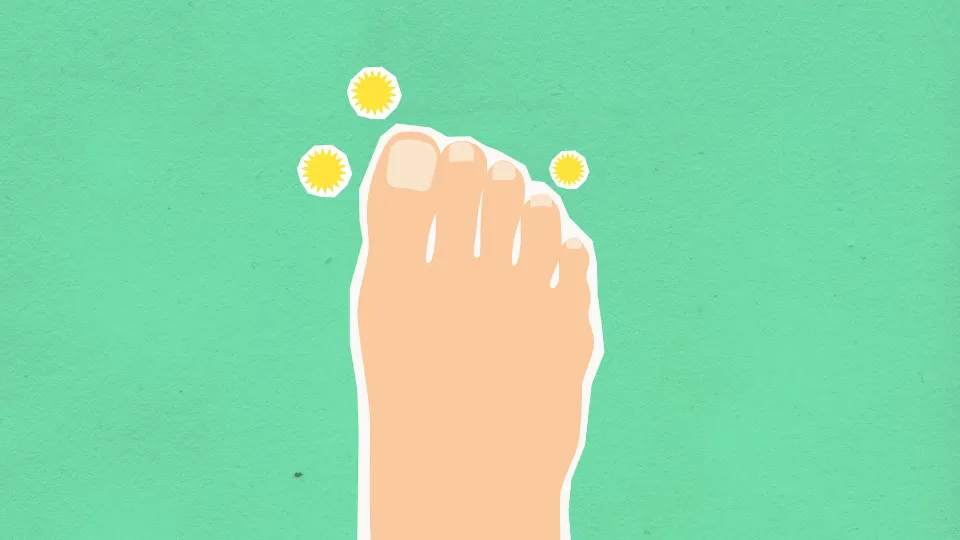An underlying medical condition could be indicated by purple or blue feet. Some possible causes of foot discoloration include injury, Raynaud’s disease, peripheral artery disease, and frostbite.
The skin may bleed and turn blue or purple, but this color change could also mean that not enough oxygen-rich blood is getting to the area. Due to their distance from the heart, the feet are particularly prone to discoloration.
Temporary skin color changes may not be harmful, but recurring or persistent foot discoloration may be a sign of a medical condition. In this piece, we examine some potential causes and remedies for purple feet.
Causes: Why Are My Feet Purple?
Lupus
Systemic lupus erythematosus, also known as lupus, is an autoimmune disease, meaning that healthy tissues and organs are mistakenly attacked by the body’s immune system. Lupus symptoms can impact numerous body parts, including the feet, and range greatly in type and severity.
Extreme fatigue, swelling and pain in the joints are typical lupus symptoms. Up to one-third of lupus patients also have Raynaud’s disease, claims the Lupus Foundation of America.
Inflammation of the blood vessels, or vasculitis, can result from lupus. When vasculitis occurs in the feet, it can cause a rash in the form of red or purple dots on the skin. Various other body parts may also develop this rash. Numbness, tingling, and a loss of strength in the foot may also be brought on by vasculitis.
A doctor should be consulted by anyone exhibiting lupus symptoms. Lupus treatment is based on the symptoms. Treatment for mild vasculitis, which only affects the skin, is typically less intensive than for lupus, which affects various body parts.
Frostbite
Because healthy circulation to your internal organs takes precedence over regular blood flow to the extremities, cold temperatures can reduce circulation in your hands and feet. You might only need to change from the chilly indoors to the warm outdoors, put on some gloves, or put on some socks to get your fingers and toes back to normal circulation.

The risks are significantly greater when it is extremely cold outside. When your skin is exposed to extreme cold, frostbite can happen. The most vulnerable areas are typically your face, hands, feet, and ears. Exposed skin becomes red and hard from superficial frostbite. However, severe frostbite can cause the skin to turn purple. The skin may continue to be purple even after it has warmed up. This is considered a medical emergency.
The best way to prevent frostbite is to avoid exposure to extreme cold temperatures. Wearing clothing that shields your entire body from the cold is a must.
Ischemic Foot
Ischemia refers to a reduction in healthy blood flow in one or more arteries. If you have ischemic foot, it means that your foot isn’t receiving enough oxygen-rich blood.
A buildup of cholesterol plaque in one of the major arteries supplying blood to your foot can cause ischemic foot. You could also have a blood clot that’s blocking blood flow in an artery. From blunt trauma or puncture wounds, an artery can occasionally suffer harm. Risk factors for ischemic foot include:
- high cholesterol
- high blood pressure
- diabetes
- having a history of vascular problems
- obesity
You might experience pain in your lower legs and feet when you walk in addition to purple toes and feet. Serious cases may even cause you to experience pain while you’re lying down.
Maintaining healthy blood pressure, cholesterol, and sugar levels is essential for preventing ischemic foot. This may require medications, as well regular exercise and a diet that will help keep your weight in a healthy range. Additionally, you ought to give up smoking because it can seriously damage your blood vessels.
Raynaud’s Disease
In some ways, acrocyanosis and Raynaud’s disease are related. In both cases, the skin turns blue or light purple and is frequently brought on by cold weather. But, episodes of Raynaud’s can come and go, and may last for a few minutes at a time. Acrocyanosis episodes tend to persist. Additionally, acrocyanosis affects the larger arteries in your feet and hands, whereas Raynaud’s disease affects the smaller blood vessels in your fingers and toes.
Primary and secondary Raynaud’s are the two varieties. Primary is unrelated to an underlying condition and can be so mild that you may not even be aware you have it. Secondary Raynaud’s is usually a complication of a more serious condition, such as:
- scleroderma
- other connective tissue diseases
- carpal tunnel syndrome
- diseases of the arteries
Raynaud’s is more common in women than in men. Although anyone can get it, it usually starts in your teens or early 20s.
Treatments: What Can I Do With My Purple Feet?
Treating Lupus
Lupus is treated with a variety of medications. As your symptoms and needs change, your doctors and nurses may adjust the medication they prescribe for your lupus.
Types of medicines commonly used to treat lupus include:
- Nonsteroidal anti-inflammatory drugs (NSAIDs). Ibuprofen and naproxen, both NSAIDs available over-the-counter, are effective at easing minor joint and muscular pain and swelling.
- Antimalarial drugs. Malaria medications include those for joint pain, rashes, fatigue, and lung inflammation. Two common antimalarial medicines are hydroxychloroquine (Plaquenil) and chloroquine phosphate (Aralen). According to studies, taking an antimalarial drug can prevent lupus flare-ups and possibly lengthen the lives of those who have the disease.
- Other medicines. Treatment for conditions like osteoporosis or high blood pressure that are related to your lupus may require additional medications. Blood clots, which can result in a stroke or heart attack, are another risk that many lupus patients face. Your doctor may prescribe anticoagulants (“blood thinners”), such as warfarin or heparin, to prevent your blood from clotting too easily. Pregnancy is not a time to take warfarin.
Treating Frostbite
Initial frostbite and other cold-weather injuries can be treated by soaking the affected skin in a warm bath for about 30 minutes, then allowing it to air dry. Avoid rubbing ice burns. Give it careful attention, and have a doctor examine it. If any tissue is permanently damaged, it may have to be surgically removed. Toes may be a part of this.

Treating Ischemic Foot
You may need to take antiplatelet drugs like aspirin in addition to maintaining proper control of your blood pressure, cholesterol, blood sugar, and smoking cessation. In extreme cases, surgery may be necessary to join a blood vessel from another part of your body to the affected artery, providing a path for blood to travel around the constricted area.
Treating Raynaud’s Disease
In cold climates, putting on gloves and thick socks may help lessen episodes. It may also be necessary to take drugs like calcium channel blockers or vasodilators, which keep the smaller arteries open. Usually, less invasive treatments are sufficient. In serious cases, nerve surgery that removes tiny nerves from around blood vessels in your affected feet or hands may help lessen the response to cold temperatures.
Conclusion
Purple feet could have a variety of underlying causes. Skin discoloration can be caused by bruising after a minor injury. Although it can be a sign of an underlying medical condition, purple or blue skin can also denote restricted blood flow to the feet.
Numerous conditions, including Raynaud’s disease, PAD, lupus, diabetes, and frostbite, can impair blood flow to the feet. Anyone with persistent or recurrent foot discoloration should consult a physician.
FAQS
What Does Poor Circulation in Feet Look Like?
A person with poor circulation may experience swelling in the ankles and feet, discolored or blue and red toes, hair loss on the legs, and thin, dry, or cracked skin. Last but not least, poor circulation is almost always a symptom of another disorder or illness.
Why are My Feet Turning Dark?
Areas of darker skin color in the lower leg, ankle or foot are called Hemosiderin deposits. A brownish pigment called hemosiderin is produced when red blood cells’ iron content, or hemoglobin, breaks down. Stasis Dermatitis, also known as foot and ankle discoloration, is typically a sign of venous insufficiency.



